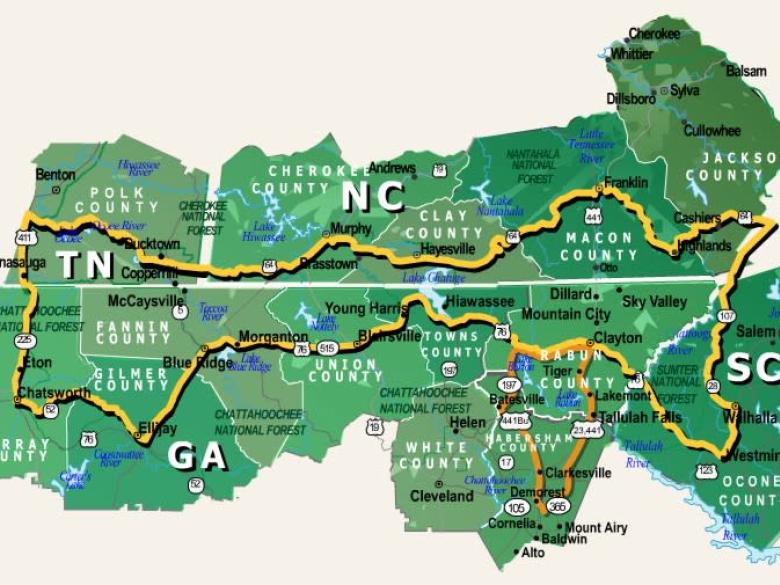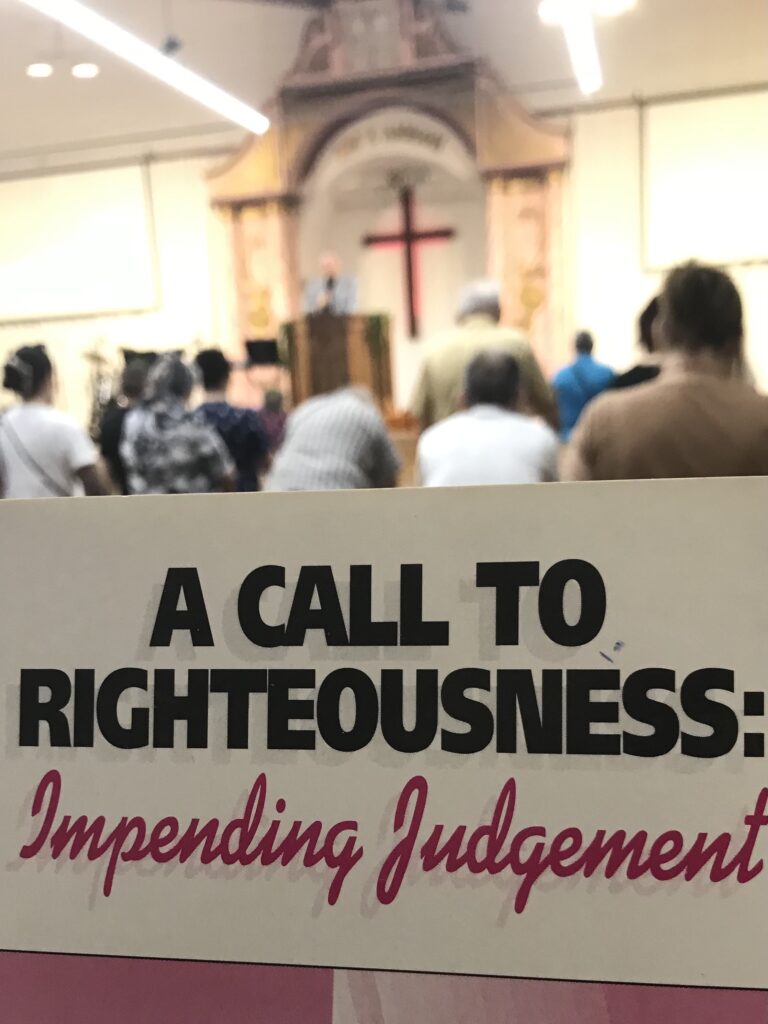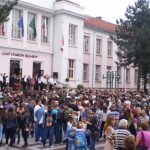175 DAYS of REVIVAL

25 Years Southern Highroads Preacher

Dony K. Donev, D.Min., Th.D.
Now, let me spin you a tale of my first pilgrimage to Cleveland, a place nestled in the crook of the Appalachians, where the hills whisper secrets older than Methuselah’s beard. It was New Year’s Eve, 1995, when I rolled in from the wind-whipped streets of Chicago. Cold? Why, it was colder than a banker’s heart in a foreclosure! Snow? Piles of it, heaped high as a politician’s promises! Blizzardy? I reckon the Almighty Himself was shaking out His winter quilt, burying the world in flakes as big as goose feathers. I stepped out of my baby blue Grand National, shivering like a plucked chicken.
My second jaunt to these parts came in the golden autumn of 1997, when I took to the Southern Highroads Trail. If you ain’t never seen that ribbon of road in the fall, with the leaves blazing like a painter’s fever dream – reds and golds fit to shame a king’s ransom – well, you’ve missed a slice of Heaven. I’ve driven that trail so often since, my automobiles could nearabout navigate it blindfolded. There was that old Buick, a candy-apple-red 1.6 CRX, spry as a jackrabbit; a pair of Volvos, sturdy as Swedish hymns; and a Dodge that grumbled but never quit. Why, those machines know every twist and turn of that road better than I know my own signature.
It all began in earnest during my first semester at seminary, a trial that’d make Hercules himself throw up his hands and take to whittling. Picture this: a load of 26 credit hours, 13 papers to scribble (each one a literary ordeal to rival the labors of Job), 13 Sunday morning preaching appointments down in South Carolina, and a mere 12 weeks to wrestle it all into submission.
Some Sundays, I’d stand in a pulpit near Clemson, preaching three times till my throat was raw as a buzzard’s breakfast, then climb into my car and tear back up Southern Highroads that very night, the stars winking like they knew my hurry. Other times, I’d be at revivals, driving down every day and back again after we’d lingered at the altar well until midnight. The Southern Highroads became my confessor, my companion, and my taskmaster, and my trusty steeds.
My cars learned its ways by heart, carrying me through the dark. A winding path that stretched like a ribbon tossed across the hills of Appalachia, a spirited jaunt, kicking off in Clemson and sashaying through Seneca and Westminster, before hightailing it straight to Clayton, where the mountain hills stand like old philosophers. Back in those days, that South Carolina stretch was a speedster’s dream and my little CRX Si loved them curves like a fiddler loves a reel!
Nowadays, they’ve gone and fancied up the road with new bridges and turns, especially near the new resorts and golf clubs, where folks swing clubs at little white balls and call it a good time. But back then, it was wilder than the Wild West, full of twists that’d test a mountain goat’s nerve. My CRX danced through those bends leading up to Clayton in 30 minutes or less with the glee of a schoolboy let loose on a summer’s day. Now, I ain’t saying I broke all the laws of man and nature on the Southern Highroads, but I reckon that road and I had an understanding. It whispered, “Go on, son, give it a whirl!”
After crossing downtown Clayton, I pressed the pedal hard toward Hiwassee. Thirty minutes, maybe less. The road was much clearer back then. The three 10-mile-an-hour curves past the scenic view were much gentler then. Beyond them, the passing lane opened up, and the car held steady at 80, sometimes 85, for a good stretch. I once dreamed of a great white cross on the hill at Clayton’s edge. Now it stands there atop the hill, shining like a lighthouse in the night.
Hiwassee meant something to me later, not then. In the ‘90s, I passed through fast, aiming for Young Harris and Blairsville. Murphy was a place I circled around on purpose. Decades on, I learned Young Harris was Methodist, married to a Mormon woman. Back then, they were just one red light towns, brief midnight shadows on the dark no moon road, gone quick as I drove, weary from preaching all day. My 75-mile half-way point there was a green painted gas station that is now long gone. An RV dealership sits there now or maybe a repair shop.
The night always hung-over Blairsville like a cheap suit, wrinkled and heavy with the promise of trouble. I swung my car right at the fork where First Baptist now sits always bypassing Murphy. Back then, that corner was just a pumps-and-gravel affair, the kind of place where a man could fill his tank and his thoughts with nothing but the hum of crickets.
My next destination was the Big Bear gas station at Decker’s Market, a lonely outpost where the road met nothing but shadows. From there to Ducktown’s Piggly Wiggly, via the twisting snake of Wolf Creek, it is exactly 14 miles as the crow flies. This old preacher, with a Bible in one hand and a lead foot on the gas, could carve that stretch in ten minutes flat.
Time’s a thief with a mean streak. The Piggly Wiggly’s gone now, selling nothing but broken dreams instead of canned beans and green okra. Ducktown’s got itself a red light right at the front of the store, blinking red and waiting for something that ain’t coming back.
The Southern Highroads climbed and fell, a hard stretch of asphalt past the Whitewater Center, now just ashes and memory. Then it dived sharp into the Ocoee. I would be half asleep by then, eyes heavy, but my hands knew the wheel. Each turn came clear -left, right, left again – with a rhythm burning into me like an old saint’s prayer. The road didn’t care about the years or the sermons I’d preached. It just stretched on, leading me through the ghosts of shadows laying over the white waters of the Ocoee and toward a horizon that always seemed one turn away. Until the last turn by the dam and into the four-lane leading into ol’ Cleveland.
Now, I ain’t no hero, mind you, just a fellow, preaching His Word and rattling along them Southern Highroads like a pilgrim with a cause for over a quarter century now. But if you ever find yourself in Cleveland on a snowy New Year’s Eve or a crisp fall day, take a drive on that Southern Highroads trail. And you’ll see why my cars, bless their iron souls, never forgot the way.

Bulgarian Socialist Leader Expelled
September 25, 2024 by Cup&Cross
Filed under Featured, News, Publication
With over 100 votes at today’s meeting of the National Council of the BSP, they expelled the resigned leader of the party, Kornelia Ninova. She was at the head of the formation for eight years. The decision was supported by 105 votes “for”, 16 “against” and four abstained.
Along with Ninova, Georgi Svilenski, Ivan Chenchev and Krum Donchev were excluded from the left formation. There are seven reasons for the release of Ninova and her three party members. Among the main reasons for their exclusion is non-compliance with the decision from which constituency Ninova and Svilenski should run for parliament.
„ Legally, we are in absolute precedent – a chairman who is expelled from the party but is chairman by court order. Give us time to think about the situation. Our efforts must be aimed at the BSP’s appearance in the elections,” said the resigned leader Ninova. She added that they refused to vote by roll call at the plenum.
Gheorgi Svilenski said that the agenda of the National Council of the party consisted of two points – about the current situation and about the domestic political order. “For the second point, the reasons for imposing punishments on the four should have been read – to Cornelia Ninova, to me, to Ivan Chenchev and to Krum Donchev. There were no reasons for this decision and Zafirov’s answer to Donchev was: “In principle”. Donchev is excluded “in principle”. This decision was made between 65 and 70 people, and people who are not members of the National Council were also present in the hall, Svilenski said, adding that he had asked the presenter Christian Vigenin three times to check the quorum, but he had refused.
In his words, the procedure for Ninova’s exclusion is not the same as the steps for the release of other party members. “She was elected chairman of the party by 57,000 socialists”, he added.
Ninova explained that on the one hand she wants to leave the leadership post, on the other hand her fellow party members want her resignation. “This can only be done in Congress, they refused to call Congress, they refused to let me in. They will keep me here as a hostage to legitimize their iniquities. I have given a power of attorney to Georgi Svilenski and Ivan Chenchev, they will participate in the registration of the lists, she added.
Moscow Hit by Ukrainian Drones
Ukraine has unleashed what was reportedly the heaviest drone attack so far against Moscow. The overnight raid on the Russian capital killed at least one person and caused significant damage and disruption. As is typical for Ukrainian attacks of this kind on targets in Russian territory, there was no immediate comment from Kyiv. Russian officials, however, responded angrily, accusing Ukraine of deliberately attacking civilian areas.
One of Putin’s slaves goes to film herself watching Ukrainian drones pour onto Moscow. pic.twitter.com/rtZob2gplv
— Jay in Kyiv (@JayinKyiv) September 10, 2024
In all, Russia claims that it brought down at least 20 Ukrainian drones over the Moscow region, and 124 more over eight other regions. While these claims cannot be independently verified, available videos posted to social media make clear the fact that this was a significant and sustained attack, with the Moscow region being particularly heavily hit.
At least one person, a 46-year-old woman, was killed in Ramenskoye, near Moscow, according to Russian authorities, when fire engulfed a high-rise residential building, leaving another three people wounded, according to regional governor Andrei Vorobyov. Meanwhile, 43 people were evacuated to temporary accommodation centers. “Dozens” of homes in the region were reportedly hit.
Several videos show, from very close quarters, a drone impacting a Moscow high-rise building, although it’s unclear if this is the same one that was struck in Ramenskoye.
First Day of School in Bulgaria
Never Forget
150 DAYS of REVIVAL
September 1, 2024 by Cup&Cross
Filed under Featured, Missions, News, Publication

Bulgaria’s “new” caretaker cabinet takes oath before October 27 early elections
The second Dimitar Glavchev caretaker cabinet took the oath of office in the National Assembly on August 27, hours after President Roumen Radev signed the decree naming October 27 as the date of Bulgaria’s next early parliamentary elections.
The special sitting of the National Assembly for the swearing-in, called during Parliament’s recess, lasted just eight minutes, including the oath-taking and playing of the Bulgarian and European Union anthems.
Glavchev will head an interim government with just three personnel changes compared with the one that took office in April and that subsequently underwent minor changes.
Controversial figure Kalin Stoyanov is out as caretaker Interior Minister, but his successor in that portfolio, national police chief Atanas Ilkov, has been described by some parliamentary groups as similarly serving Movement for Rights and Freedoms (MRF) co-leader Delyan Peevski.
Peevski said last week that were Stoyanov excluded from the next caretaker cabinet, he would place him on his list of parliamentary election candidates.
The other changes in the second Glavchev cabinet are deputy foreign minister Ivan Kondov taking over the Foreign Minister portfolio, until now held by Glavchev, and Transport Ministry legal department head Krassimira Stoyanova taking over the Transport Minister portfolio from Georgi Gvozdeikov.
The October 27 elections will be the seventh time in just more than three years that Bulgarians elect a legislature. Only two of those elections produced an elected government, neither of which served a full term in office.
A Call to Righteousness over Bulgaria
























